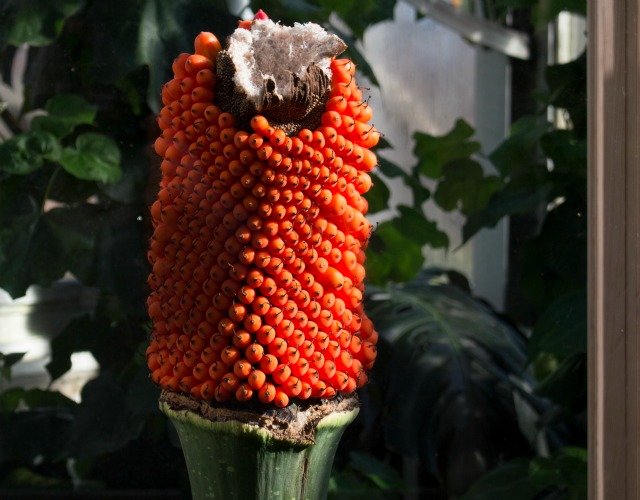The Botanic Garden's Stinky Corpse Flower Is Producing Fruit
By Marielle Shaw in Arts & Entertainment on Jan 18, 2016 7:50PM

Corpse flower via Marielle Shaw/Chicagoist
It's been awhile since the talk of the town revolved around a giant Sumatran flower that smells like rotten meat on a hot day, but we haven't forgotten Chicago Botanic Garden's summer of the corpse flower.
First up was Spike, a local and internet celebrity of a plant that was on display and 24/7 webcam for 3.5 weeks. It was an exciting time waiting for news of its stenchy arrival, but sadly, it lacked the energy to bloom, and never opened. The gardens were quiet for a bit, and we wondered if we'd missed our chance to see a botanical blue moon. But behind the scenes, horticulturist Tim Pollak was holding out hope that another amorphophallus titanum the Botanic Gardens team was calling Alice, would produce the bloom and fumes fans had missed the first time around. Alice looked healthier from the beginning, noted senior scientist and Ph.D. Patrick Herendeen, and took even garden staff by surprise when it started to bloom at 11 p.m. on Sept. 28, only a few weeks after Spike's premature slumber. About 8000 visitors showed up the next day to get a glimpse of the garden's new golden girl.
Now there's cause for celebration again, because Alice the Amorphophallus has produced fruit! In a free lecture at the Chicago Botanic Garden this past Sunday, Pollak and Herendeen detailed their journey with these remarkable plants, and the collaboration it had taken to get there. Titan arums, they explained, rarely self-pollinate, relying on carrion insects to do the job in nature. To pollinate Alice, the team at the gardens delicately applied the plant's strange strands of pollen with paintbrushes. The pollen that was used to produce Alice's fruits came from both Spike and Stinky, the Denver Botanic Garden's corpse flower. The fruit, which we found out has not been reported as edible for humans, takes a while to mature, and gradually deepens color from a bright yellow to an orange red and reaches the size of a quarter.
After the lecture and a field trip to the tropical greenhouse to see Alice in full fruit, we got a chance to visit with Titan Tim and Pat Herendeen and talk a bit more about the titans, the summer, and what it meant to them.
Did you expect the corpse flowers to generate so much hype?
TIM POLLAK: No... Spike and Alice blew [other botanical gardens] out of the water, as far as what we expected, as far as people coming, and the interest. It's a tribute to the media, the PR team...it blossomed into a big mushroom cloud of news.
What do you think it is about the corpse flowers that drives the interest? Is it because they're so big, so weird, or that they take so long to bloom?
PATRICK HERENDEEN: It's a combination of all of those things. Tim talked about botanic gardens sharing materials. They also share advice, and a number of botanic gardens have said, if you have one of these plants, when they come into flower, you have to be ready, they predictably reliably bring in the crowds. In this case, it all came together to be much greater numbers of people than we anticipated.
What was your favorite part of the experience?
P: Talking to the visitors. It's a great opportunity to talk about science and botany- plants, and how all that stuff works.
T: And the kids. The interest in kids' eyes when they turned the corner and could finally see the plants. They were asking intelligent questions more than the adults were, some of them.
What do you hope people will take away from this?
P: Plants are cool! Nature is unpredictable...
T: Plant conservation. I mean, certainly we're teaching and educating about the conservation of this. We want to bring it back to real biology and horticulture questions, and societal questions in terms of deforestation. Basically, though, it's plants are cool, too!
If you, like us, were fascinated by Chicago's corpse flowers, be sure to stop by the tropical greenhouses at the Chicago Botanic Gardens some time before April 8 and see Alice's amazing fruits.